Chapter Twenty-Three
Off to Europe
In the spring of 1967, Master Subramuniya embarked on a fourteen-week journey to Europe which he called the Actinics’ World Tour. With three monks and five family members, he flew to Paris, bought a used Volkswagen van, and set out to visit fourteen countries. In each nation, they visited spiritual leaders; they met with monks in Swiss monasteries and priests in Roman theological seminaries. The budget for the tour was small—a mere $2 a day per person for room and board—so the group camped out, throwing their sleeping bags down in French wheat fields and bathing in streams in Germany’s Black Forest. Twice the group checked into a rural inn and indulged in a hot shower. §
It was a wild and wonderful adventure. They bargained for Persian carpets in the casbah in Tunis and, due to a breakdown in American-Algerian relationships, were taken off a plane and held hostage at gunpoint in an Algerian airport for 36 hours. §
In Venice, Master spent three days exploring a previous life experience. With two monks, he walked around the entire city, occasionally hiring a gondola. He was consciously looking for a certain place, outside a theater, he said. He looked and looked for hours. On the third day, he suddenly exclaimed, “Here it is! This is the place where I was killed in a previous life. I was just leaving that small stage door over there after an opera performance when someone came up behind me, hit me in the head and threw me into the canal to drown.” §
Master mentioned later that night that he was always reluctant to sing in this life, and he attributed it to that horrible death long ago. He confided that it was hard to leave the body of that opera singer, because it was turning out to be such a nice life. §
In Ascona, Switzerland, he spent two weeks at Casa Eranos, Carl Jung’s charming summer chalet on the shore of Lago Maggiore, a massive mountain lake shared by Italy and Switzerland. Meditating, giving upadeshas and browsing through Jung’s personal library, Master discovered the famed psychologist’s penchant for Indian philosophy and his deep engagement with kundalini. §
One morning a young monk asked the guru to describe the inner light. A few words of response came, but suddenly Master grew pensive, excused himself and retired to his room. After some hours, the monks knocked tentatively on the locked door to invite him to lunch, but he told them he was busy. Hours passed, and again they knocked, with no response. Though they were loath to disturb him, this was so unusual the group began to worry aloud whether they should intervene. §
While those deliberations were underway, Master unlocked and opened his door, calling them all to join him on the open stone patio that overlooks the lake. It was late afternoon. With them seated around, he brought out a yellow pad of paper, the kind lawyers write on. Beaming and clearly happy about something, he repeated the morning’s question about the light, then revealed that he had “brought through” a small book during those solitary hours. He announced the title, The Clear White Light, then proceeded to read the manuscript, a profound explication of the mystical experience. Aside from Cognizantability, it was to be the only major work he ever wrote in his own hand, all others having his inspired talks and dictations as their source. Here is an excerpt.§
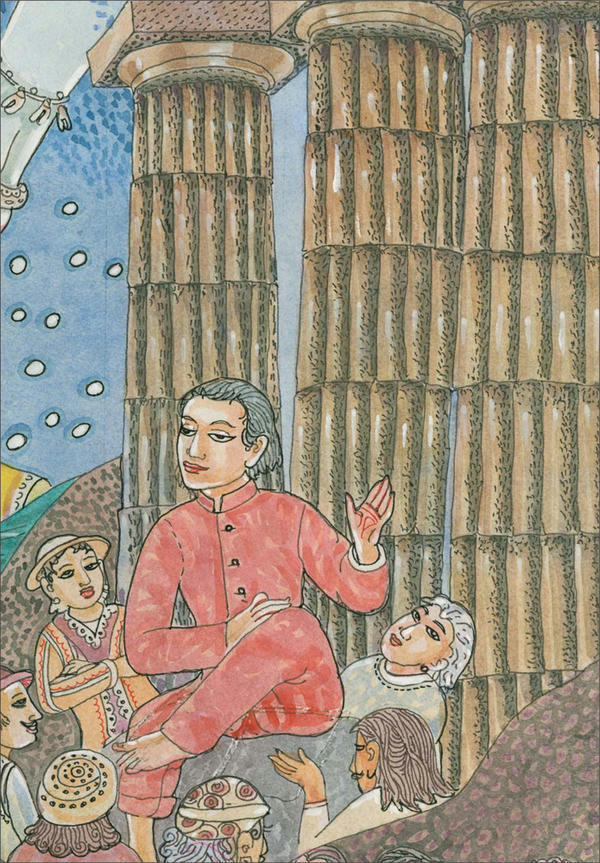
The travel-study programs in Europe took Innersearchers to the great historic places, such as the Parthenon in Greece. Wherever they went, Master spoke of the eternal Self within. It was the constant rock on which he sat.
• • • • • • • • • • • • • • • • • • • • • • • •§
It is a great new world of the mind that is entered into when first the clear white light dawns, birthing a new actinic race, immediately causing him to become the parent to his parents and forefathers. When living in an expanded inner state of mind, he must not expect those living in materialistic consciousness to understand him. On this new path of “the lonely one,” wisdom must be invoked to cause him to be able to look through the eyes of those who believe the world is real, and see and relate to that limited world in playing the game as if it were real, thus maintaining the harmony so necessary for future unfoldments. To try to convince those imbedded in materialism of the inner realities only causes a breach in relationship, as it represents a positive threat to the security they have worked so hard to attain.§
First we had the instinctive age, of valuing physical strength and manly prowess, followed by the intellectual age, facts for the sake of facts, resulting in the progress of science. Now we are in an age of new values, new governing laws, an actinic age, with new understanding of the world, the mind, but most of all, the Self. Understanding is preparation for travel, for it is an age of the mind, and in the mind, much more intense than the speed of light, exist spheres which seers are only willing to speak of to those who have the inner ear with which to listen.§
The mind of man tends either toward light or toward darkness, expanded awareness or materialistic values. Depending upon the self-created condition of the mind, man lives either within the clear white light of the higher consciousness, or in the external mind structure which reflects darkness to his inner vision.§
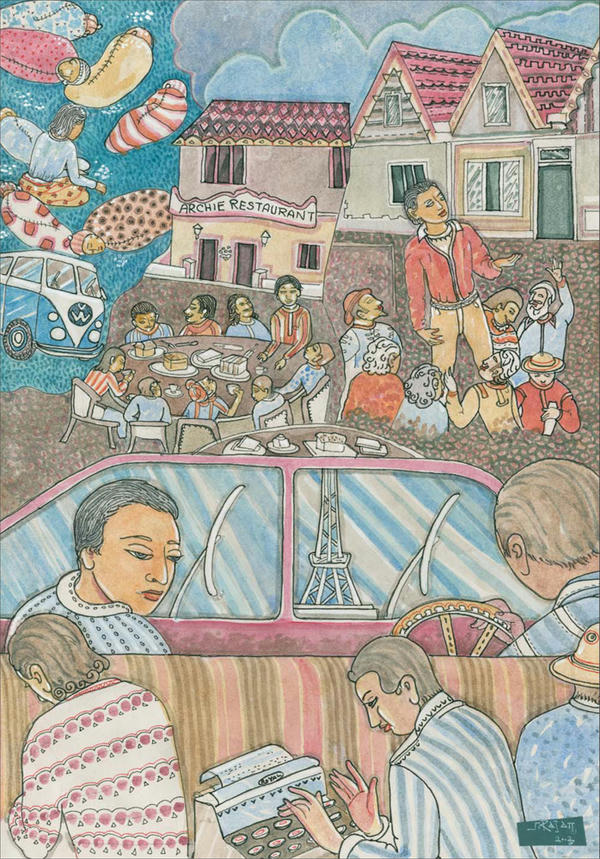
In 1967 Subramuniyaswami explored Europe with monks and family devotees. Traveling in a VW van, overnighting in fields in sleeping bags and eating on two dollars a day, the group brought advaita yoga to the continent. Master dictated “Yoga Letters” from the front seat while a monk in the back typed.
• • • • • • • • • • • • • • • • • • • • • • • •§
Leaving Switzerland, the nine Actinics drove north, through Austria, Germany, Luxembourg, Belgium and Denmark. Master’s purpose was to spread his Advaita Yoga teachings throughout Europe; and toward the end he lectured at Sorbonne University in Paris and sponsored the first-ever yoga conference in Amsterdam, bringing a hundred yogis and yoga teachers together from throughout Europe. §
As they drove week after week through Europe, Master sat in the front seat of the Volkswagen, dictating the “Yoga Letters” to a monk sitting in the back with a portable typewriter. The van became a mobile writer’s studio, and all enjoyed listening as the teaching of the day flowed forth in his rich voice. When one was finished, they would stop at a local post office and mail the typed papers back to the monks in Virginia City to be dutifully published so all at home could follow Master’s journey. Here is an excerpt.§
There is another great exerciser of the inner nerve currents, and that is using our willpower. This is where the term inner strength comes from. It is through practices such as finishing a job once started, doing each job perfectly, keeping promises and just living a life in accordance with one’s highest ideals that these inner currents are strengthened. When a person has been using his inner willpower to accomplish his goals, you can feel his inner strength emanating from within him. When that person sits down to meditate, he will undoubtedly attack his meditation in the same manner, strengthening even further these inner currents. §
The desire to meditate comes from positive accomplishments which have been gained through the practice of meditation itself. After a certain number of successful meditations, the subconscious begins to anticipate the next meditation until the mind is so conditioned that it constantly holds a meditative vibration. At this point, the desire for meditation is automatic and meditation becomes a way of life. Then, the energies and understanding of the fourth dimension are always available and are an ever-present part of a person’s life. §
“Shout It from the Rooftops”
Returning to America, Master dove into the spiritual regimens he loved so—Sunday sermons, monks’ training, radio interviews, the long desert drives to his Nevada monastery. He had gained some fame as a yoga teacher and, to his surprise, was invited to be a guest professor at UCLA for a week, lecturing from The Master Course. He held a similar series at the International House in Berkeley for UC students, lectured at Stanford and traveled on an extensive speaking tour through Southern California, Colorado, the East Coast, British Columbia and Washington. In Seattle he gave talks on Hindu mysticism and esoterics at the Aquarian Foundation, a spiritualist, occult church established in 1955 by Rev. Keith Rhinehart, whom Master knew well. §
It was a time of reaching out, taking the deepest teachings into the colleges and communities around America. It was not a time to remain silent about the Self, he would say, but to “shout it from the rooftops.” American youth were remarkably open to this mystical message during those few years, as never before or since.§
During 1968, Master Subramuniya lectured extensively in the Midwest for the first time and participated in a television series at San Francisco State College that featured dialogue with Zen Master Roshi Suzuki. Weekends were passed in San Francisco, but most of the week found him at the Nevada monastery, which became his primary home and new headquarters. His time was spent more and more with the monastics and with his published works. §
Yoga and meditation were a vital part of personal, individual sadhana for all of Master’s followers. Each was instructed to hold a fifteen or twenty minute meditation without fail after waking in the morning and before sleep. These inner explorations would become the anchor of their lives, giving them a security and insight that made each day joyous and each experience welcomed. Whenever their karmas became too intense and they came to him for relief, he would ask first if they were meditating regularly. Usually, for those whose balance had been lost, the answer was no. §
The emphasis of Master’s talks in the early 60s was on the awakening of the superconscious and the possibility of realizing the Self by clearing the subconscious. Encounter groups had gained popularity—therapy sessions where people shared things that were otherwise taboo and unspoken. Using the term Enter-In, Master implemented, for his monks only, group sharing. §
To facilitate subconscious cleansing for his family members, he instituted the practice of confession, called Agni Yoga, personal sharing with the guru of one’s past, of those hidden repressions that hold us back on the path. Students with deep-seated repressions, painful memories and bottled-up character tendencies that they had never been able to confront or talk about would often come into their first inner light experience after going through a soul-searching series of confessions. §
This was a major area of training for the early monks, as they listened, under Master’s guidance, to hundreds and even thousands of confessions. He taught them how to take the energies of those personal revelations and draw them into the light where they would be resolved, not by analysis, not by any rational insight, but simply by being in the presence of the clear white light.§
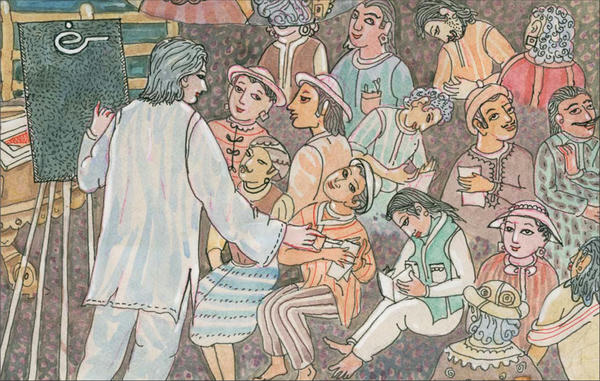
On a small patio overlooking Lago Maggiore in Switzerland, Master taught his mystical Shum language for the first time. It would become his preferred way of sharing the penetrating, occult and subtle depths of the mind.
• • • • • • • • • • • • • • • • • • • • • • • •§
Birth of a Mystical Language
In July of 1968 Master led 32 students on a travel-study program called Innersearch Switzerland. He had long been dissatisfied with presenting the philosophy and concepts of Hinduism and yoga in English. The subtle states of meditation and intricate inner disciplines cannot be easily conveyed through the medium of an externally oriented language like English, he found. At Casa Eranos, Master went deep within, seeking a solution that would allow humanity better access to and understanding of the interior states of consciousness spoken of in Hindu sacred texts. §
After a series of meditations, on the morning of July 28 the alphabet of the Shum language came forth from the inner mind, first one character, then another, as he sat in deep meditation clairvoyantly seeing and clairaudiently hearing the character’s form and sound. When he had written them all down, he ran outside excitedly waving the paper in his hand. “I’ve got it! I’ve got it!’’ he said to one of the monastics passing by. He showed what he had done and dedicated much of the remainder of the retreat to bringing out more. An entirely new language of meditation—its basic alphabet, script, syntax and first vocabulary words, called pictures and portraits—was developed during the retreat. §
In the summer of 1968, Himalayan Academy conducted an Innersearch Travel-Study Program to Ascona, Switzerland. I was working on a little book called The Advaitin. The book was about the refined states of experience deep within the inner realms of pure consciousness, just before one merges into the Self and after one comes out of that state. The little book was unfolding beautifully, but upon rereading what had been written, I thought, “This is very understandable to me, but would it be so to someone just beginning on the path? It’s going to be so complicated, so difficult to understand, for what I wish to portray in words, there are no words in the English language.” I then began to feel that what should be done was to begin using Sanskrit to provide the necessary, adequate words so that the inner and refined areas of the mind would have their own name in the same way emotions, physical things and so forth are named in English.§
At our Ascona summer retreat, this theory that unfolded from within was going ’round and ’round in my mind, and I began looking through several Sanskrit dictionaries to locate certain words that could be used in The Advaitin. But in three Sanskrit/English dictionaries, each translator had translated each of the words in a different way. I threw up my hands at this and said, “This is going to make it more confusing for my beginning students than if we didn’t use Sanskrit,” simply because of the differing translations.§
The feeling began to come that what was really needed was another language, a new, fresh language, one giving me a vocabulary that we could use to accurately describe inner states of consciousness. Two or three days later we traveled to Venice for a few days’ excursion. This idea of a new language was still strong in my mind. It was in Venice that I decided to go deeply within and bring out a new esoteric language. So, I went deep within myself, and wrote down a message of instructions dictated by one of the Mahadevas to my outer self. The Mahadeva explained how and where to go within to be able to unfold another language. My instructions were, “You go within the uda current, which is found within the sushumna.” That is the current of mind flow where language exists.§
In following the instructions, my spine lit up in a beautiful, pale yellow and lavender light. The yellow and the lavender intermingled, one color coming in and out of the other. It was just beautiful! But I only found one end of the uda current, and did not have any results in Venice. Three days later, after returning to Ascona, Switzerland, while working within myself, I found both ends of the uda current. Then, in meditation, after coming out of nirvikalpa samadhi, I heard the tones of the svadishthana, the anahata and the ajna chakras. Within two hours, out of my inner mind came the script, the basic alphabet of eighteen sounds, the syntax as well as some of the basic vocabulary, like simshumbisi, vumtyeudi, karehana. The first word to be uttered was Shum. §
Shum now names the mystical language of meditation. As fast as I could, I wrote it all down and ran downstairs to one of the monks, shouting, “I have it! I have it! Here is our language!”§
Because of the immediate need for a vocabulary of fifty or a hundred words for me to work with during the Innersearch Travel-Study Program, I was eager to proceed in bringing through the new language. Shum started out in a very simple way. I thought, “Fine. Now we will have ten or fifteen or twenty or maybe a hundred more words eventually to work with, and they will be marvelous inner teaching tools.” However, in the days to follow, this uda current became stronger and brighter and brighter. I didn’t tell anyone about it at the time except two or three of the Saivite monastics who were with me in Switzerland.§
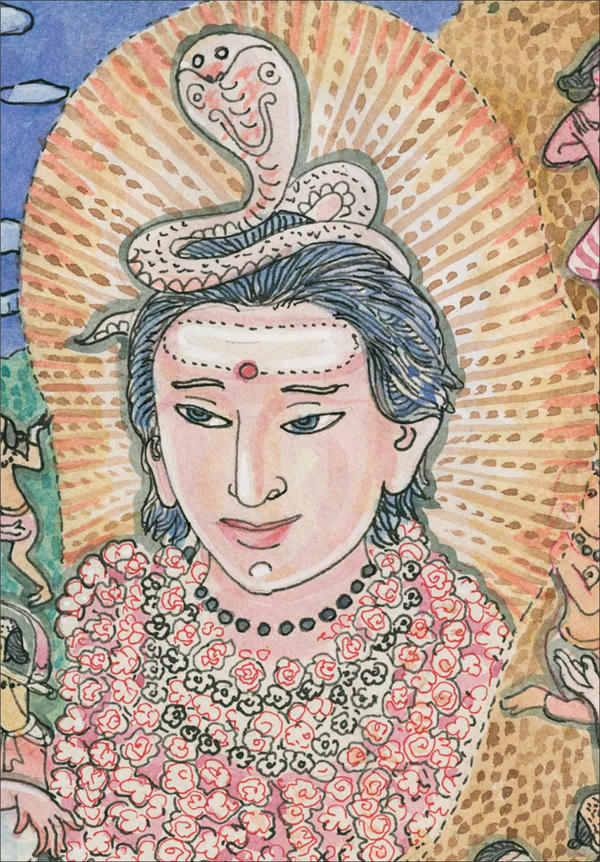
Sometime around 1968, following decades of sadhana, Sri Subramuniya had the experience of the kundalini coiling itself permanently at the top of the head.
• • • • • • • • • • • • • • • • • • • • • • • •§
I began working day and night, and the structure and script for the language began to refine itself, and vocabulary started coming through, right from the inner light. I would see light within my head and see little images or letters in the Shum script drop down one after another and line up. Then I would read the word, like shumsimnisi, and know what it meant, and then write the Shum word with the meaning in English. Vocabulary flowed out like this for two or three weeks. In Nice, in Southern France, the whole concept of liunasi, the psychic nerve system, and alikaiishum, the warmth and psychic heat of the body, came through. §
Then, later in our Innersearch, in Paris, more of Shum came through. Upon returning to the United States, I had a vocabulary of about 300 words, and every day more were coming to Earth. Finally, the images stopped dropping out of the inner light, and I would hear the meaning of the word clairaudiently, almost as if someone were speaking. Sometimes they would come in reverse—English first, Shum second. The vocabulary and the structure of the language developed quickly, but what is more important, the perspective of the Shum language was available. §
In the Shum language, the perspective is deep within the mind. It is called shumif. From this perspective, we have the consciousness that we are the center of the universe. We see light within the spine as the central pole, and then open our eyes and look out into the world. §
The following year, 1969, we returned to Switzerland and experienced the tremendous breakthrough of mambashum. These are Shum maps of areas of meditation that enable a devotee not only to map out his meditation before he begins it, but to make memos of the meditation as it progresses. Now devotees are able to go back to the same area of the inner mind, time and time and time again. By following the same mambashum, more than one person can go into the same area of the mind, time and time and time again. Mystical experiences began to develop between myself and the devotees, as we would go into the same area of the mind and experience, see and hear the same sounds, see the same colors—which is an event that is not made known in mystical and occult literature. §
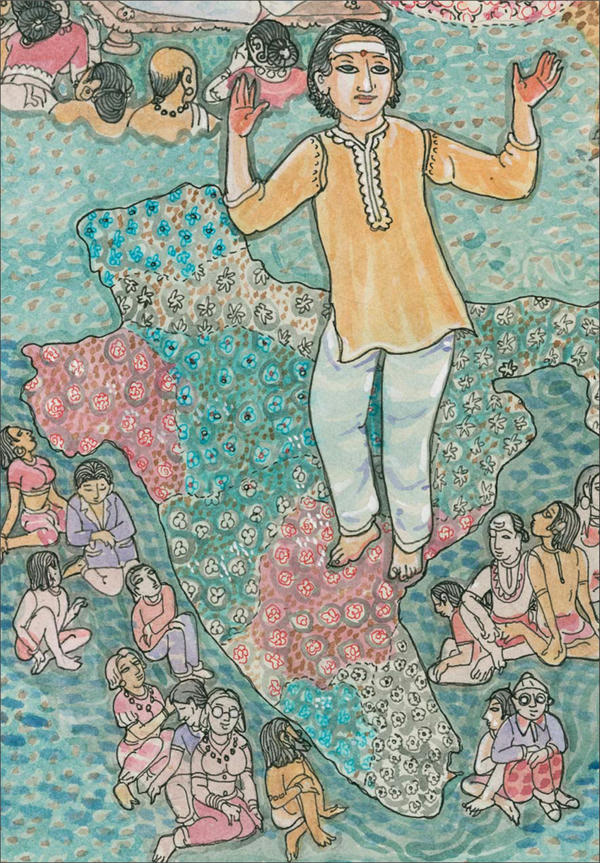
For thirteen weeks in 1969 Master Subramuniya guided 65 devotees around the world on the India Odyssey. It was his first return to India and Ceylon since 1949, and it began decades of interaction with those two nations.
• • • • • • • • • • • • • • • • • • • • • • • •§
Mutiny in the Mountains
Returning after the 1968 Innersearch to Nevada after four weeks in Europe, Master was faced with unfortunate consequences of his longer-than-usual absences. A small band of mutinous monks, led by the most senior, approached him with the outrageous suggestion that he retire; they would carry on the mission from now on.§
Keeping his poise in the face of this challenge, Master invited the group to dinner at Miguel’s, a Mexican restaurant in Reno, bringing along an equal number of monks who thought the brazen insurgence was preposterous. En route, he shared his strategy with those who were with him. They would listen to the rebels’ reasons and ideas, learn more of their plans and remain nonresponsive. §
During dinner, the rebels were disarmed by the lack of negative response and openly told Master that his absences from the monastery were too long and he was, after all, not getting any younger (at 41). They freely shared their ideas for the future, which amounted to transforming the monastery into an open institution, less strict and more New Age.§
Master left the restaurant without directly responding and never spoke to the group again on the subject. In the days and weeks to follow he moved one monk, then the next, to another monastery, another mission, slowly reducing the responsibilities of those involved and dismantling the opposition. As the years rolled on, each of the renegades found the courage to leave the monastery. Years later Swami Satchidananda faced a similar takeover effort from his board of trustees, and Master sent his senior monks to help him successfully turn back his subversives.§
In the months that followed, Master spent more time in his remote Nevada ashram, leading the monks in the regimen, followed in those days, of four one-hour meditations each day. The Shum revelations had intensified his mystical experiences. Of that time, he wrote:§
A sannyasin of attainment has had many, many lifetimes of accumulating this power of kundalini to break that seal at the door of Brahman. Here is a key factor. Once it is broken, it never mends. Once it is gone, it’s gone. Then the kundalini will come back—and this gives you a choice between upadeshi and nirvani—and coil in the svadhishthana, manipura, anahata, wherever it finds a receptive chakra, where consciousness has been developed, wherever it is warm. A great intellect or a siddha who finds the Self might return to the center of cognition; another might return to the manipura chakra. §
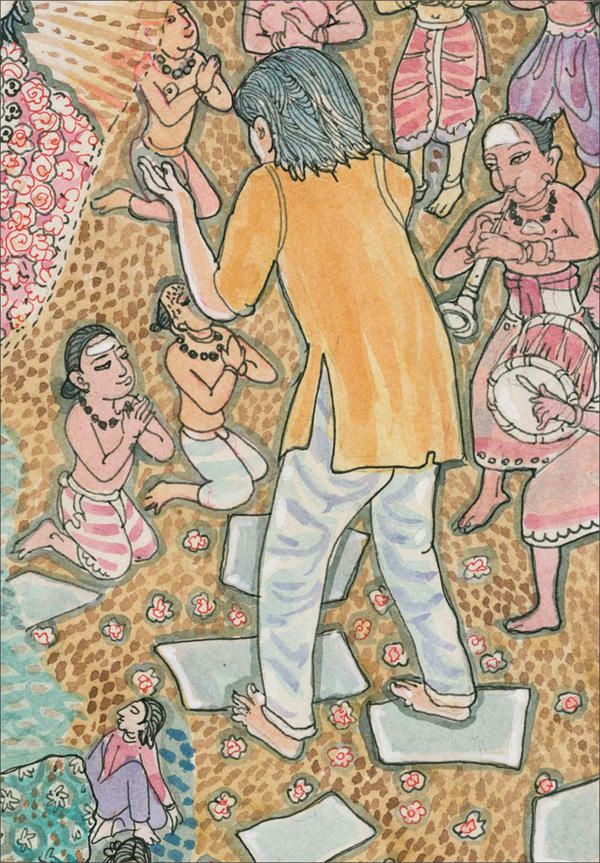
During the 1970 Tahiti-Ceylon Innersearch, Master was regaled by the Saivite community of Ceylon. Tavil and nagasvara heralded his arrival in fifty villages, and miles of hand-woven cloth was laid on the ground for the holy man from the West to walk upon.
• • • • • • • • • • • • • • • • • • • • • • • •§
The ultimate is to have the kundalini coiled in the sahasrara. I personally didn’t manage that until 1968 or ’69, when I had a series of powerful experiences of kundalini in the sahasrara. It took twenty years of constant daily practice of tough sadhanas and tapas. I was told early on that much of the beginning training was had in a previous life and that is why, with the realization in this life, I would be able to sustain all that has manifested around me and within me as the years passed by. Results of sadhanas came to me with a lot of concentrated effort, to be sure, but it was not difficult, and that is what makes me think that previous results were being rekindled. §
The Garden Island
There was a second Innersearch in 1968, this one to Hawaii in December, called Ashram Kauai. Master took 27 students to the Garden Island of Kauai, spending three weeks at a remote country resort called the Tropical Inn. They had the entire facility to themselves and turned it into an ashram. Situated four miles inland along the Wailua River, the inn, built in 1929, overlooked a lush river valley and offered a dramatic view of the island’s extinct volcano a few miles away. It seemed like paradise. §
For years I had been looking for a new international headquarters through which I could expand the activities of my teachings and be more available to those around the world. I traveled through eleven different countries during the summer of the first Innersearch, and later many successive Innersearches around the world, covering 27 different countries in all, until I finally decided to establish my headquarters on the island of Kauai.§
So much was everyone taken with the place that the devotees suggested it be purchased for the Church and optimistically took up a collection among themselves, the beginnings of a down payment. One morning they placed $480 in Master’s hand, urging him to make this remarkable site his home. It was not for sale, but he set the money aside for its intended purpose.§
The World’s Finest Waiters
Returning to Nevada and San Francisco in early 1969, Master was challenged with the growth of his order of monastics. How could he support them, feed and house them, afford to train them? The monastics had, up to this time, lived in rented quarters in the neighborhood or in the temple building. In a new building he purchased for the monks, a new form of training was commenced, a program that had the monastics work in San Francisco restaurants. Master developed it to provide them skills of dealing with the public in busy situations, to mature their abilities to handle details and work with others, to help instill the spirit of humble service so essential to monastic life and to maintain the self-sufficiency of their order at a time when it had few other sources of revenue. §
The goal was to become “the finest waiters in the finest restaurants in the world,” which required the monks to exert maximum effort in personal discipline and deportment. To further their training, Master instigated an elaborate training program in fine waitering for the monastics, hiring professional maitre d’s, sommeliers, chefs and restauranteurs of high standing in the city to instruct the monastics through lectures and demonstrations.§
For years the monks worked anonymously in some of the city’s finest restaurants, surrendering their earnings at the temple altar each night and spending their off hours and days in the monastery and with the guru. Master called the program Silent Ministry, as the monks went out incognito, carrying the vibration of the temple into the world to uplift and bless all those they served and worked with. It was an arduous sadhana, with long, late hours in intensely demanding conditions. For those who persevered, it proved to be a great training, one that strengthened the brotherhood and matured the young men. They did, in fact, become some of the finest waiters in some of the finest restaurants in the world.§
An Odyssey to India
Master Subramuniya traveled again to Europe, this time with five monks and twenty-seven students in July and August on Innersearch Switzerland 1969. Portugal, France and Switzerland were the chief countries visited, with half of the month-long pilgrimage being spent in retreat at Casa Eranos. Here he again devoted his time to developing the Shum language, using its conceptual portraits to elucidate the Advaita Siddhanta philosophy. He sponsored at Casa Eranos a special training session for European yoga teachers living in Germany, France, Italy and Switzerland.§
In October, along with twelve monks and fifty-four students, he undertook a thirteen-week pilgrimage to India and Ceylon. The pilgrimage, called the 1969 Indian Odyssey, visited France, Greece, India, Nepal, Ceylon, Singapore, Thailand and Japan, with the greater part of the time being spent in India, where Master’s group was the largest tour ever to visit the country. It was large enough that the Minister of Aviation and Tourism, Dr. Karan Singh—who years later would visit Kauai and take Master as his “Western guru”—helped with the arrangements personally. In each country, the spiritual leaders were sought out—a master calligrapher in Japan, a Buddhist roshi in Thailand, and in India a galaxy of yogis and great souls. §
This was Master’s first visit to India in two decades, and the first time ever for the students traveling with him. India captivated, confounded, challenged and uplifted. India was, they concluded, the last place on Earth where magic lived on the streets and divinity lived in the eyes of the people. §
One-week retreats were held in Darjeeling and Udaipur in the Himalayan foothills and at Ootacamund in the Nilgiri Hills of South India. One day he took the pilgrims to a local theater to see the newly released movie, “2001: A Space Odyssey.” Shum was again a major study for the pilgrims, and his devotees were introduced to orthodox temple worship. In Madras he held the International Yoga Convention. §
What was most dear to Master during this three-month odyssey was his return to Ceylon, Satguru Yogaswami’s home. Twenty years had passed since he left the island, and he had longed to be back. The Saivites of Jaffna received him with enormous respect, with pomp and ceremony spiced with a little uncertainty. They knew Yogaswami had said, “I have a man in America,” and they could see that the American guru was a remarkable soul, but there was resistance, a reluctance, to take a Western man as spiritual master. It had never happened, and some were determined it never would. But Master paid them no heed. He had his mission from Yogaswami and he would carry it forward, with or without them. §
He sponsored special feasts and festivities centering around the Subramuniya Ashram and initiated a resident program for his monastics there, whereby they would stay for extended periods at the ashram to broaden their personal exposure to Hinduism and gather scriptures for publication in the West. Temple pujas, temple talks, cultural events and gatherings filled the days. With not a single hotel in the area, Innersearchers stayed, in twos and threes, in the homes of Yogaswami’s disciples, living the Saivite culture they had only heard tales of, learning the charms and subtleties of the East and making the deep human connections that would tie the East and the West together for decades. §
Master was home. All could feel it. He stayed at the home of Kandiah Chettiar, who had introduced him to Yogaswami, and renewed their connections. He wore a white veshti everywhere, to the surprise of all who had never seen him in one. Feeling the time to be auspicious, he gave advanced dikshas to monastics and devotees and made plans for his Alaveddy Ashram to expand its service to the Tamil community. §
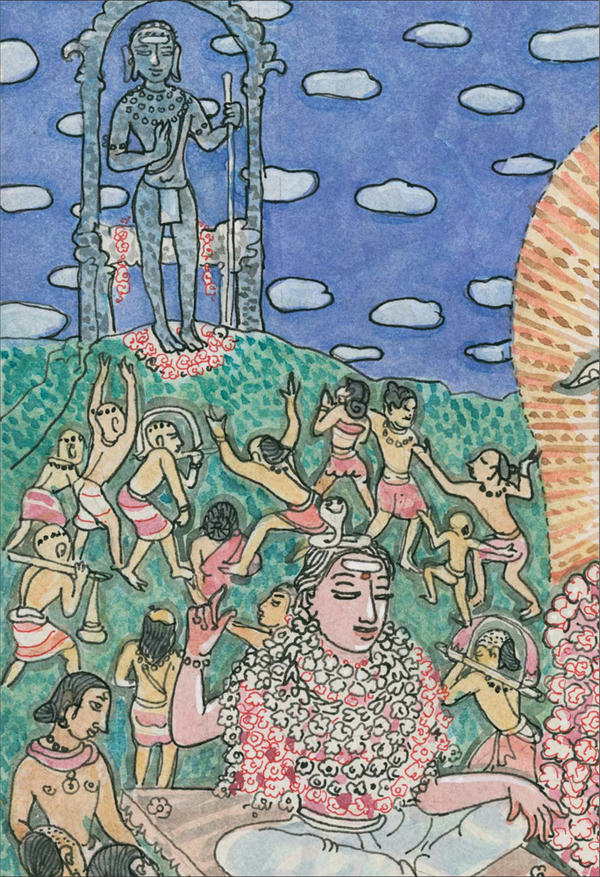
During the 1972 Indian Odyssey, seventy-two Innersearchers circled the globe with the satguru. In Palani Hills, Madurai Meenakshi-Sundareshvara and other temples, crowds buried him under mountains of garlands and heralded him as Hinduism’s hope for a noble future.
• • • • • • • • • • • • • • • • • • • • • • • •§
He worshiped at Nallur and Kumbhalavalai and at Yogaswami’s hut, met with all the senior Sri Lankan disciples and visited an aged, wisp thin and white-haired Markanduswami in his thatched hut. To the amazement of everyone, Master prostrated to this solitary sage, something that never happened before, an act that was taken as his way, after all these years, of honoring the guru they shared. Nor did Markanduswami fail to enchant all present. As each Innersearcher entered, he was painstakingly careful to follow them with his eyes, and not go to the next until their eyes, and perhaps their souls, met. Not one was missed. Seated on a wooden bench in his pure white robes, barely in his body, his hair and beard wildly uncontrolled, he regaled his visitors with the great sayings of the illumined satguru who had died just five years earlier. The Innersearchers were transformed by it all as they shared in this joyous homecoming. §
Master’s entire mission was transformed by those weeks, by the profound encounters in India and Ceylon. Having visited Hinduism’s source, worshiped at Chidambaram and immersed his followers in the ancient dharma, he would return many times, and he would bring forth like a river in spate all that he saw and remembered from his youth. No longer would India and Ceylon be a soft reference of the past. They would take center stage in his continuing efforts to bring the West knowledge of the Self and the beauties of Hindu culture. §
During the pilgrimage, a daily diary was published to inform everyone back home of the events and experiences. These Odyssey Letters were mailed to Virginia City, printed and distributed from there to make everyone at home feel they were on the journey.§
Kauai Calls
The staff were so exhausted by the journey around the world that Master delayed their return to San Francisco and flew them to Kauai, where he had held the Ashram Kauai retreat in late 1968. They checked into a hotel at Poipu for much-needed rest. But Master seldom did well at that, and he immediately undertook a project, to explore buying the idyllic Tropical Inn they had fallen in love with. §
When Master asked a monk to inquire about such a purchase, the response came back, “But, it’s not even for sale.” “Never mind that,” Master consoled, “just go there and ask.” The monk dutifully drove the 45 minutes to the place and on his return reported that, “The owner said it’s not on the market.” “I see. Now go back and ask him, just theoretically, how much he would sell it for if it were ever to go on the market.” §
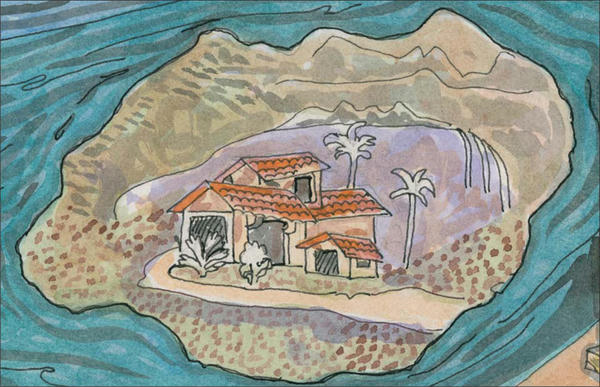
In December of 1968 Master took 27 spiritual seekers on a three-week meditation retreat to a remote Hawaiian island. Kauai, half way between the East and the West, so captured him that in 1970 he established his headquarters on the Garden Island.
• • • • • • • • • • • • • • • • • • • • • • • •§
Back at the Tropical Inn the monk dutifully spoke with the owner, retired Col. Albert Roesch, asking for a what-if price. “As my manager told you twice, it’s not for sale, young man.” “Yes, I know. But if it were...” the monk sheepishly offered. Seeing there would be no respite until a number was forthcoming, Col. Roesch grumbled in a slightly threatening voice, “If it were to be sold, and I’m not saying it ever would, we would want no less than $300,000.” Back at Poipu, Master heard the number and decreed, “Go back and tell him we can’t afford that much, but we can offer him $165,000 right away. No more. Tell him that.” “But...” “Trust me. Just go and make the offer.” An hour later the monk stood before the man and made the counteroffer with great hesitation. “Hmmm! Let me talk with my wife,” came the unexpected retort. §
The offer, amazingly, was accepted and Master moved to the new property on February 5, 1970, spending the first night alone on the property to take psychic control before inviting the monks to join him the next day. §